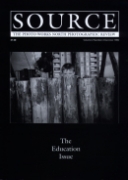Battle of the Bogside
Review by Brian Lynn
Issue 5 Summer 1995
View Contents ▸
Battle of the Bogside was shown as part of the West Belfast Festival during August and combines the work of Clive Limpkin a freelance photographer from England and Barney McMonagle from the Brandywell in Derry.
Images of confrontation can be difficult to assess as so often, like words, taken out of context or their time sequence, the true reasons for the actions are distorted and clouded depending on how the photographer or editor intends the viewer to judge them. Conscious of this I approached the exhibition with an open mind with no preconceived ideas of looking for who was right and who was wrong in their actions. Clive Limpkin
Clive Limpkin
On leaving the exhibition I tried to take stock and sum up how it had affected me. There was something in the photographs, an unsophisticated honesty which came through strongly. I felt the cameras had been used as recording machines - documenting characters acting out a live drama. Time and time again I felt drawn to the onlookers - the bystanders frozen to the spot with little choice but to watch the scenes unfold before them. Scenes like the sinister one we can only conjecture on, which made the two young children scream horribly while holding their mother's hand while she and another young mother gaze incredulously on. There are many pictures featuring children each one with a strong yet different message. The school children caught unsuspectingly in a stream of tear gas or the close-up of a 'child soldier' wearing a gas mask and wielding a petrol bomb, what was going through his mind, what happened to him and where is he now?
Some of the most disturbing images centred around the dead and injured and how in turn the living reacted. When you suddenly hear of the death of a relative or close friend whether it is expected or not doesn't it leave, even briefly, a palpable space, vacuum or void as it dawns on you that they are gone? I felt this coming through visually in some of these photographs whether of the dead lying bleeding on the pavement or the injured being tended by a comrade. In one such image of an injured soldier being helped, the spectators looked genuinely concerned - no smiles or cheers here, more a feeling of disbelief that these events where actually happening, on a day which had the possibility of being just another ordinary day in Derry.
Other images which have that 'ordinary' look about them come to mind - the pedestrian ducking under an army SLR aimed from a street corner as if it was something he did naturally every day. There was a wry humour implied in the action as if to say that life must go on in spite of the situation.
I often think poster sites and the images and words plastered on them are waiting for a real life analogy to suddenly be enacted below them, providing a ready made image for the fortunate photographer. One such Guinness advertisement headed by the text "The most natural thing in the world" provides the background to a street with its barricade mid frame and two men in the foreground hurling missiles at a wall.
In another image a poster urges us to "Support Radio Free Derry" with the addition in hand writing of "not UTV, BBC, RTE lies", it seems to express succinctly the feelings of an entrenched community fighting for recognition.
As to that community's identity now I did feel a chance was missed by the organisers of the festival to show a parallel exhibition of how life in the Bogside has changed since then, and to look forward in a positive way, to a better future for that area.
Other articles by Brian Lynn:
Other articles on photography from the 'Documentary' category ▸






